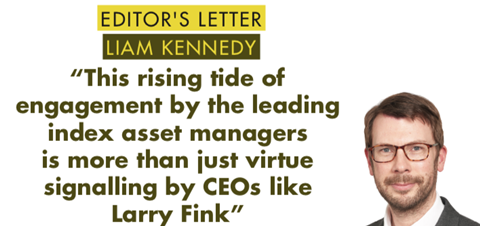In the last year, there has been a broad shift in corporate governance focus towards social issues, including human capital management – the ‘S’ of ESG.
The proxy voting adviser Glass Lewis notes majority support for a record number of such proposals, including on diversity in the 2020 US proxy season, and this focus is set to continue following human capital management disclosure rules announced by the Securities and Exchange Commission last autumn.
CEO pay has come under the spotlight this AGM season as investors have taken a dim view of companies that have benefited either from government subsidies or employment support/furlough schemes, but failed to appropriately modify executive pay to reflect that.
The diverging fortunes of businesses in different sectors through the pandemic highlights the complexities faced by remuneration committees in setting CEO pay – with companies like Marriott seeing a 60% fall in revenues over 2020 and others like online retailer Wayfair reporting a 55% increase.
Whereas, Marriott CEO Arne Sorenson announced a board pay cut in early 2020, investors this spring revolted against special stock awards in the cases of GE and AT&T in non-binding votes that nevertheless sent a clear signal from shareholders.
Chipotle Mexican Grill introduced a metric to tie executive pay to the ESG goals it says are material, but raised eyebrows by excluding several months of poor sales in 2020 from its overall bonus calculations citing “COVID-related modifications”.
Of course, shareholders will recognise that companies need to incentivise and recruit the right people to drive long-term value. As Dambisa Moyo, author of How Boards Work, published last month, points out in this issue, CEO pay in the US has grown 940% in real terms since 1978, while the pay of a typical worker has only grown by 12%.
According to the UN-backed Principles for Responsible Investment, income inequality has the potential to “negatively impact institutional investors’ portfolios as a whole”, as well as damaging output, reducing growth and contributing to populism and protectionism.

To some degree, reporting executive pay ratios in relation to median employee compensation gives boards an incentive to consider the incomes of the lowest paid employees but, as Moyo argues, it is for boards to defend disparities between executive pay and the median or lowest paid cohort.
Linking executive pay to ESG, as in the example of Chipotle and an increasing number of other companies, should be viewed with caution, to ensure metrics are designed appropriately and not an exercise in ticking sustainability boxes without driving long-term value.
Overall, climate related proposals remain a primary concern for institutional investors following successes last year at Phillips 66 for proposals to outline the business risks of petrochemical operations and investments, and in the case of Chevron to disclose details of climate lobbying activities.
This rising tide of engagement by the leading index asset managers is more than just virtue signalling by CEOs like Larry Fink.
Passive in more than just name, everyone, including the index asset managers themselves, once assumed they would routinely support management. They were even habitually excluded from roadshow events only a few years ago, according to the shareholder consultancy Morrow Sodali.
According to the Harvard Law School Forum on Corporate Governance, the backing of larger index managers like BlackRock, State Street Global Advisors and Vanguard has raised levels of support for climate-related proposals from 24.1% in 2019 to 31.6% in 2020.
In its Q1 2021 Investment Stewardship Report, BlackRock says it supported 75% of shareholder-led environmental and social proposals and voted against 53 directors on climate grounds.
Index managers are keen to highlight the ongoing engagement work they do in the background – although its benefits cannot be objectively quantified in most cases. BlackRock says by the first quarter of 2021, it increased the number of engagements by 24% year-on-year, engaging with over 800 companies.
Added together, the three largest index houses manage client assets approaching $20trn (€16.4trn). But while they possess heft in sheer weight of assets, they can lack focus, without the resources to identify key issues at corporate level.
Activist investors are growing as a conduit for shareholder action in specific cases, whereby pension and index managers can add impetus to well-framed proposals or proxy motions, as we write in this issue (see page 54).
This can incentivise activists to table motions that support long-term value as opposed to driving short-term shareholder returns, while index managers are able to benefit from the focus of the activists in directing their resources – ultimately to the long-term benefit of all.
Liam Kennedy, Editor
liam.kennedy@ipe.com


















No comments yet